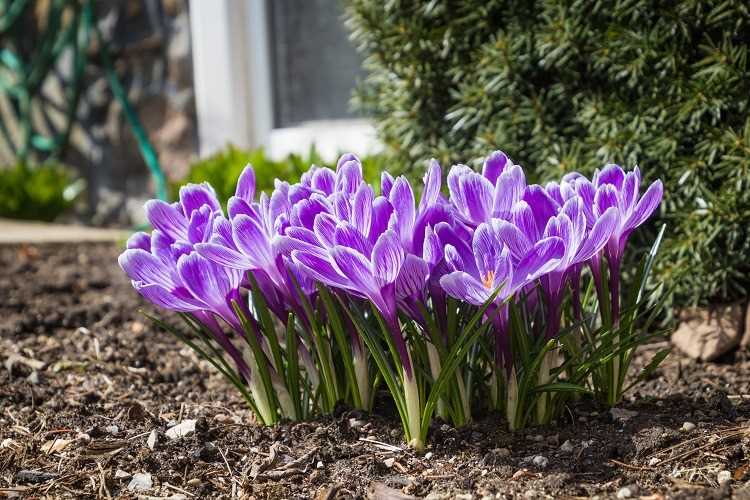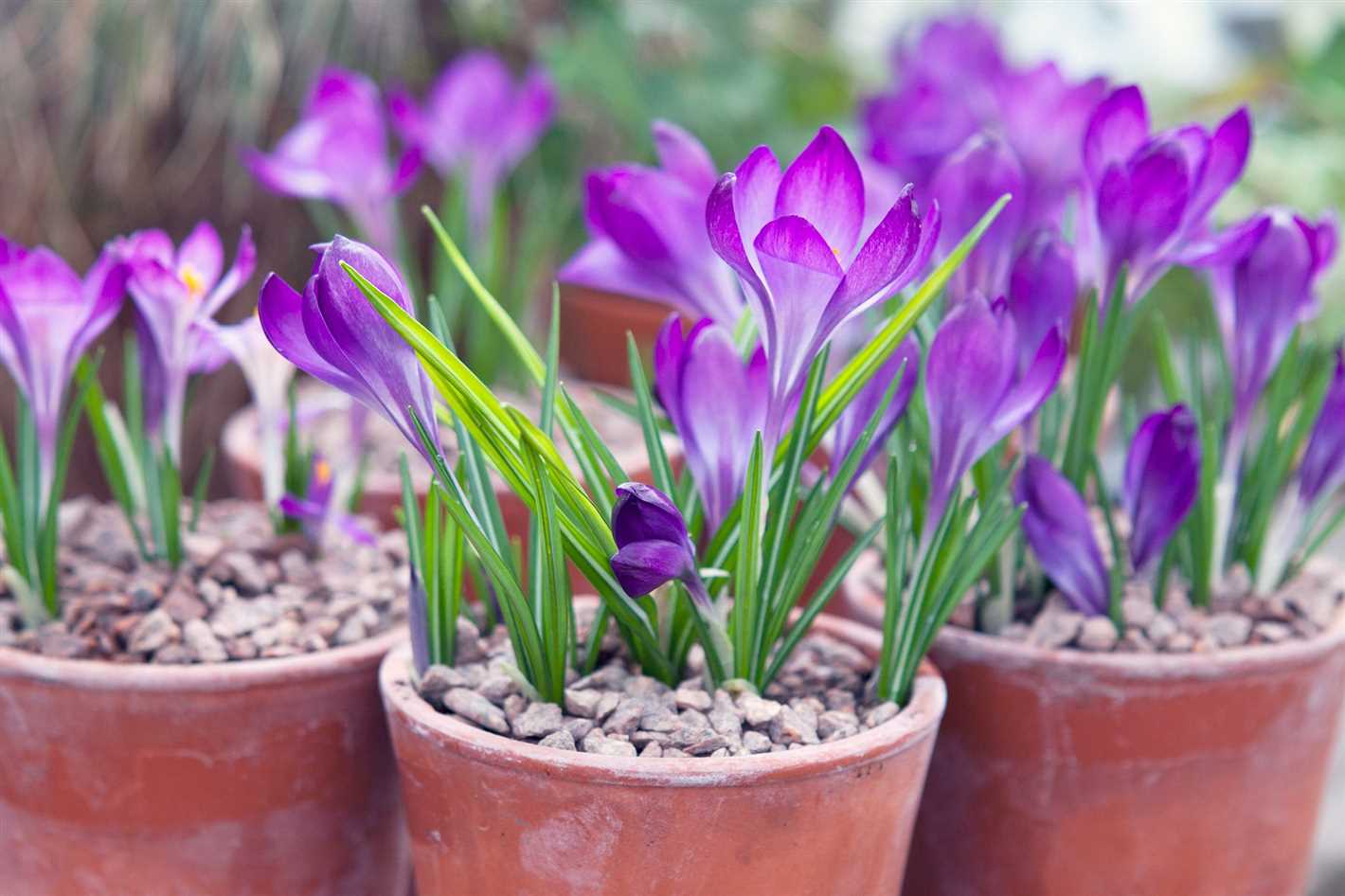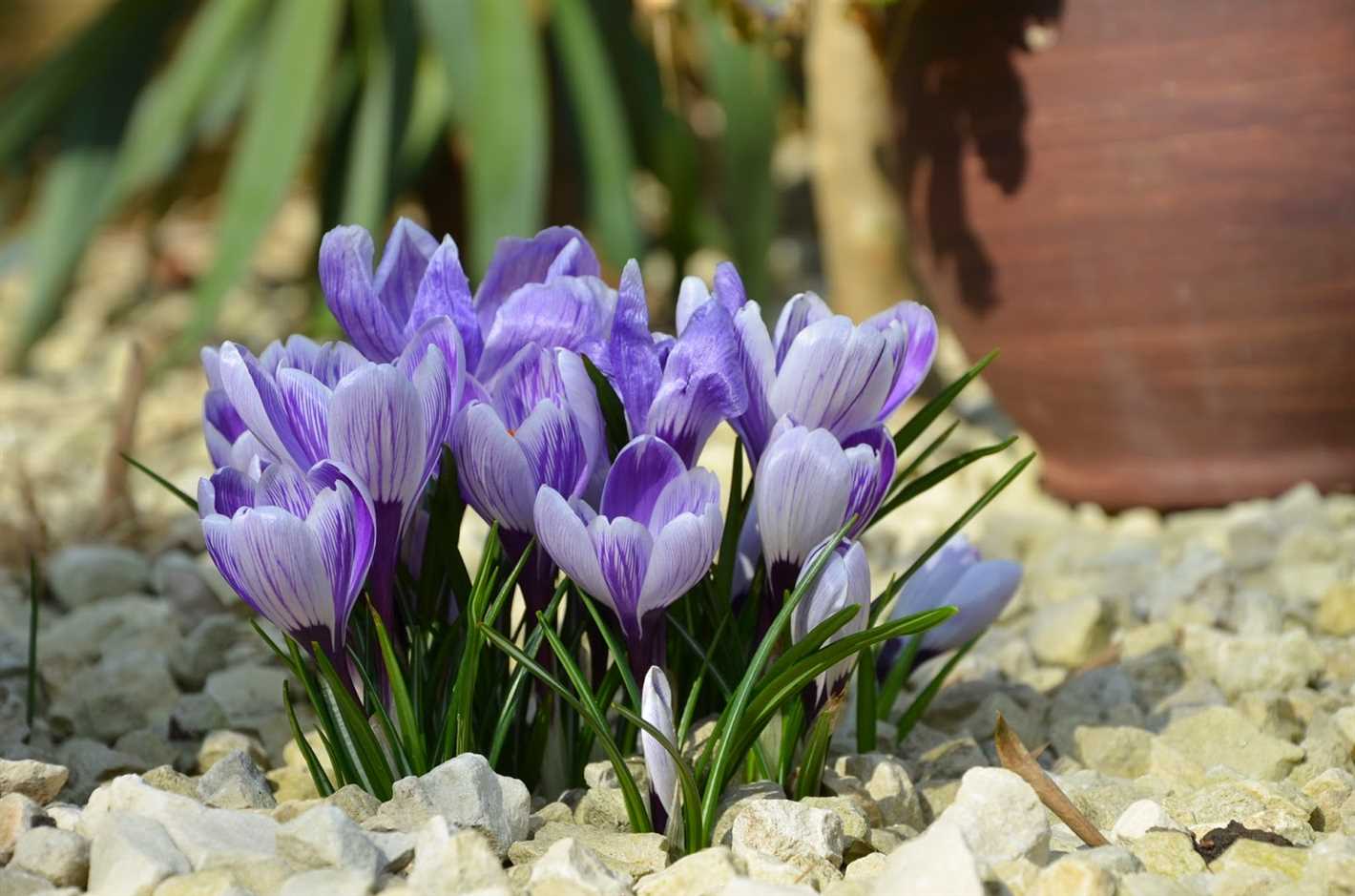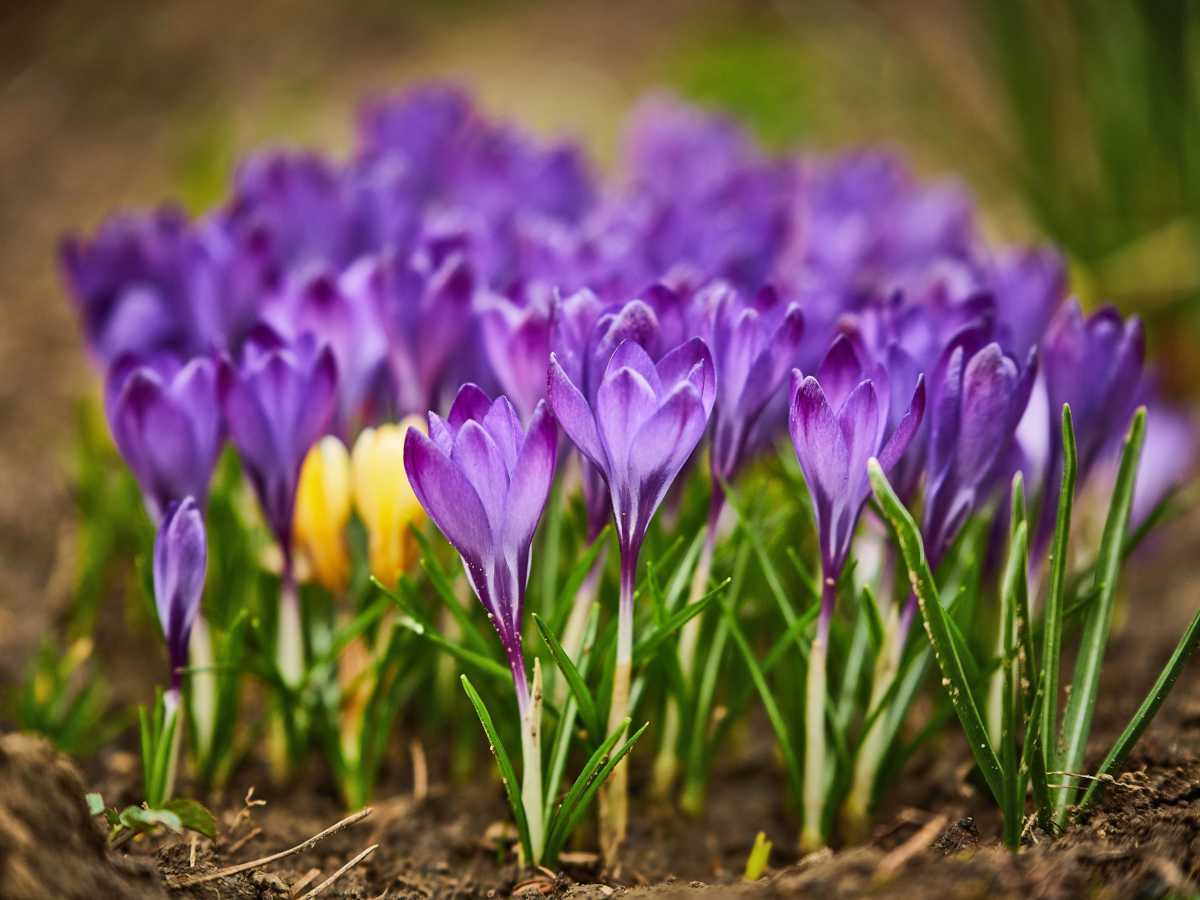- Choosing the Right Crocus Varieties
- 1. Climate
- 2. Size and Color
- 3. Early or Late Bloomers
- 4. Garden Design
- 5. Soil and Sunlight Requirements
- Preparing the Soil for Planting
- 1. Choose the Right Location
- 2. Clear the Area
- 3. Loosen the Soil
- 4. Test the Soil
- 5. Improve the Soil
- 6. Fertilize
- 7. Dig Planting Holes
- 8. Plant the Bulbs
- Planting and Placement in Your Garden
- Choosing an optimal location
- Planting the bulbs
- Grouping and spacing
- Creating a naturalized look
- Maintenance tips
- Conclusion
- Watering and Fertilizing
- Watering:
- Fertilizing:
- Protecting Crocuses from Pests and Diseases
- 1. Pests
- 2. Diseases
- Dividing and Transplanting Crocuses
- Winter Care and Maintenance
- 1. Mulching
- 2. Watering
- 3. Protection from Frost
- 4. Avoid Excessive Traffic
- 5. Pest Control
- 6. Spring Clean-up
- Enjoying the Beauty of Blooming Crocuses
- Planting in Clusters
- Choose a Variety of Colors
- Ensure Proper Drainage
- Keep Moisture Levels in Check
- Protect from Pests
- Enjoy the Early Bloomers
- Questions and Answers:
- When is the best time to plant crocuses?
- What type of soil do crocuses prefer?
- How deep should I plant crocus bulbs?
- Can I grow crocuses in containers?
- How often should I water crocuses?
- Do crocuses require fertilizer?
- How do I prevent pests and diseases in my crocuses?
- Videos: How it’s Made: Saffron – Saffron Agriculture Process Step by Step and Saffron Factory Processing

If you are looking to add a pop of color to your garden in the early spring, crocuses are the way to go. These gorgeous flowers are known for their vibrant hues and delicate petals. They are also one of the first flowers to bloom after a long winter, bringing a much-needed burst of life and beauty to your outdoor space. But how do you grow these lovely plants in your own garden? With the right tips and techniques, you can have a stunning crocus display that will impress your friends and neighbors.
Choose the Right Location: Crocuses prefer a sunny spot in the garden. They need at least six hours of sunlight each day to thrive. If you have a shady garden, don’t worry! You can still grow crocuses, but they may not bloom as fully or as early. Look for an area of your garden that gets a good amount of sunlight and is well-drained. Crocuses don’t like wet soil, so make sure the area you choose won’t retain water.
Prepare the Soil: Before planting your crocuses, it’s important to prepare the soil. Crocuses prefer well-drained soil that is slightly acidic. You can improve the drainage of your soil by adding compost or sand. It’s also a good idea to remove any rocks or debris from the area where you plan to plant your crocuses. This will give the bulbs plenty of room to grow and ensure that they have good contact with the soil.
Planting and Care: Crocuses are typically planted in the fall, around September or October, depending on your climate. The bulbs should be planted about 2-4 inches deep and spaced about 3-4 inches apart. Once planted, water the area thoroughly to settle the soil. Throughout the growing season, it’s important to keep the soil slightly moist, but not waterlogged. In the spring, as the crocuses begin to emerge, you can add a layer of mulch around the plants to help retain moisture and prevent weeds.
Tip: Crocus bulbs can also be planted in containers, making them a great option for those with limited garden space. Just make sure the container has drainage holes and is filled with well-drained potting soil.
Enjoy the Blooms: As your crocuses begin to bloom, take the time to enjoy their beauty. These flowers are a sure sign that spring has arrived and are a welcome sight after a long winter. To extend the blooming period, be sure to deadhead any spent flowers. This will encourage the plant to divert energy to the remaining flowers, prolonging their lifespan. Once the flowers have finished blooming, allow the foliage to die back naturally. This will give the bulbs the energy they need to bloom again next year.
By following these simple tips, you can have a successful crocus garden that will wow your friends and neighbors. Enjoy the beauty and joy that these flowers bring each spring!
Choosing the Right Crocus Varieties
When it comes to choosing crocus varieties for your garden, there are several factors to consider. Not all crocus varieties are the same, so it’s important to choose the ones that will thrive in your particular climate and growing conditions. Here are some tips to help you make the right selection:
1. Climate
The first thing to consider is your climate. Crocuses are native to various parts of the world, so different varieties will have different temperature and moisture requirements. Some varieties are more cold-hardy and can withstand freezing temperatures, while others prefer milder climates. Research the specific growing requirements of the crocus varieties you are interested in to ensure they will thrive in your area.
2. Size and Color
Crocus varieties come in a range of sizes and colors. Some varieties produce large, showy blooms, while others have smaller, more delicate flowers. Consider the overall aesthetic you want for your garden and choose crocus varieties that will complement your existing plants and overall design. Additionally, consider the color scheme you want to achieve and choose crocus varieties that will contribute to that color palette.
3. Early or Late Bloomers
Crocus varieties can be classified as early or late bloomers. Early bloomers, as the name suggests, flower earlier in the spring, while late bloomers flower later in the season. Selecting a mix of both early and late blooming crocus varieties can help ensure a longer display of flowers in your garden. It’s also important to consider the blooming period of other plants in your garden and choose crocus varieties that will complement or extend the overall blooming timeline.
4. Garden Design
Think about your garden design and where you plan to plant the crocuses. Some crocus varieties are better suited for naturalizing in lawns or meadows, while others are more suitable for rock gardens or along borders. Consider the height, spread, and overall growth habit of the crocus varieties you are interested in and make sure they will fit well within the existing layout of your garden.
5. Soil and Sunlight Requirements
Lastly, consider the soil and sunlight requirements of different crocus varieties. Some varieties prefer well-draining soil, while others can tolerate heavier or clay soils. Similarly, some crocus varieties thrive in full sunlight, while others prefer partial shade. Assess the conditions of your garden, including soil type and sun exposure, and choose crocus varieties that will thrive in those specific conditions.
By considering your climate, desired size and color, blooming period, garden design, and soil and sunlight requirements, you can choose the right crocus varieties for your garden. Remember to also check with local gardening experts or nurseries for specific recommendations based on your location.
Preparing the Soil for Planting
Before planting crocuses, it’s important to prepare the soil to provide the best growing conditions for these vibrant flowers. Here are some steps to take:
1. Choose the Right Location
Find a location in your garden that receives full sun or partial shade. Crocuses prefer well-drained soil, so avoid areas that are prone to waterlogging.
2. Clear the Area
Remove any weeds, rocks, or debris from the planting area. This will prevent competition with the crocus bulbs and ensure they have enough space to grow.
3. Loosen the Soil
Use a garden fork or tiller to loosen the soil to a depth of about 6 to 8 inches. This will improve drainage and allow the crocus roots to penetrate the soil more easily.
4. Test the Soil
Use a soil testing kit to determine the pH level of your soil. Crocuses prefer slightly acidic to neutral soil, with a pH range of 6.0 to 7.0. If your soil is too alkaline, you can add sulfur or peat moss to lower the pH.
5. Improve the Soil
If your soil is heavy clay or sandy, it may benefit from some amendments. Add organic matter, such as compost or well-rotted manure, to improve the soil’s texture, fertility, and water-holding capacity.
6. Fertilize
Before planting, apply a balanced fertilizer with a ratio of 10-10-10 or similar. This will provide the crocus bulbs with the essential nutrients they need to grow and bloom.
7. Dig Planting Holes
Use a garden trowel or bulb planter to dig small holes for the crocus bulbs. The holes should be about 3 to 4 inches deep and spaced 3 to 4 inches apart.
8. Plant the Bulbs
Place each crocus bulb in a planting hole, with the pointed end facing upward. Gently cover the bulbs with soil and lightly firm it down to ensure good soil-to-bulb contact.
By following these steps and preparing the soil properly, you can create an ideal environment for your crocuses to thrive and brighten up your garden with their beautiful blooms.
Planting and Placement in Your Garden
Choosing an optimal location

When selecting a spot for planting crocuses in your garden, there are a few key considerations to keep in mind:
- Ensure the chosen area receives plenty of sunlight. Crocuses thrive in full or partial sun, so avoid areas that are heavily shaded.
- Ensure the soil is well-draining. Crocuses prefer soil that is not compacted and allows for proper water drainage. If your soil tends to be heavy or holds water, consider amending it with organic matter such as compost.
- Plant them in areas where they can be easily appreciated. Crocuses are often used as early spring bloomers and can provide a bright burst of color after a long winter. Plant them near walkways, entrances, or other areas where their beauty can be easily enjoyed.
Planting the bulbs
Follow these steps to plant crocus bulbs in your garden:
- Prepare the soil by removing any weeds or debris and loosening it with a garden fork or tiller to a depth of about 6 inches.
- Dig small holes, about 3 inches deep and 3 inches apart, using a trowel or bulb planter.
- Place the crocus bulb in the hole, pointed end up. Cover the bulb with soil and gently press it down to eliminate any air pockets.
- Repeat the process for each bulb, spacing them according to the recommended spacing on the packaging or about 3 inches apart.
Grouping and spacing
You can plant crocuses either in small clusters or mix them with other early blooming bulbs for a more varied display. Consider planting them in groups of at least 10 bulbs or in clusters of different colors to create a visually appealing effect.
Creating a naturalized look
If you aim to create a naturalized look, scatter the bulbs randomly and plant them where they fall. This will mimic the effect of crocuses growing in the wild, creating a more informal and relaxed appearance.
Maintenance tips
After planting, be sure to water the bulbs thoroughly. However, avoid overwatering, as excessive moisture can cause the bulbs to rot. Crocuses are generally low-maintenance plants, but it’s important to keep an eye out for pests and diseases. Remove any fallen leaves or debris that can harbor pests or diseases, and monitor the soil moisture to prevent waterlogging.
Conclusion
By carefully selecting the location, properly planting the bulbs, and providing regular maintenance, you can enjoy the beauty of crocuses in your garden year after year. Whether you choose to plant them in clusters or scatter them for a naturalized look, these charming flowers are sure to add a splash of color to your early spring garden.
Watering and Fertilizing

Proper watering and fertilizing are essential for the health and growth of crocuses in your garden. Here are some tips to help you ensure your crocuses receive the right amount of water and nutrients:
Watering:
- Water your crocuses regularly, especially during dry periods or when they are in bloom.
- Provide enough water to moisten the soil to a depth of 6-8 inches.
- Avoid overwatering, as excessive moisture can lead to root rot and other fungal diseases.
- Consider using a soaker hose or drip irrigation system to deliver water directly to the roots, minimizing evaporation.
Fertilizing:

- Apply a balanced slow-release fertilizer to the soil in early spring, before the crocuses emerge from the ground.
- Follow the instructions on the fertilizer packaging for proper application rates.
- Avoid over-fertilizing, as this can lead to excessive foliage growth at the expense of flower production.
- Consider using organic fertilizers, such as compost or well-rotted manure, to provide a gentle and natural source of nutrients.
It’s important to note that crocuses are generally low-maintenance plants and do not require heavy feeding. However, ensuring they receive adequate water and some fertilizer will help promote healthy growth and vibrant blooms.
Protecting Crocuses from Pests and Diseases
Crocuses are generally hardy plants, but they can still fall victim to pests and diseases. It’s important to take steps to protect your crocuses to ensure they remain healthy and beautiful. Here are some tips to keep pests and diseases at bay:
1. Pests
- Slugs and snails: These common garden pests love to feast on crocus plants. To deter them, consider using organic slug and snail repellents or set up physical barriers like copper tape around your crocuses.
- Squirrels and chipmunks: These critters are notorious for digging up crocus bulbs. To deter them, you can try sowing some predator urine or using motion-activated sprinklers to scare them away.
- Deer and rabbits: If you have problems with deer or rabbits nibbling on your crocuses, consider using fences or netting to keep them out of the garden.
2. Diseases
Botrytis: Botrytis is a fungal disease that can cause discoloration and rot on crocus flowers and foliage. To prevent it, make sure your crocuses have good air circulation and avoid overhead watering.
White mold: This disease causes a white powdery growth on crocus leaves and stems. To prevent white mold, avoid overcrowding your crocuses, as it thrives in damp and crowded conditions.
Virus diseases: Crocuses are susceptible to several virus diseases, which can result in stunted growth and distorted flowers. There is no cure for these diseases, so prevention is key. Buy disease-free bulbs from reputable sources and practice good garden hygiene by removing and destroying infected plants.
| Pests | Diseases |
|---|---|
| Slugs and snails | Botrytis |
| Squirrels and chipmunks | White mold |
| Deer and rabbits | Virus diseases |
By taking these precautions and staying proactive, you can protect your crocuses from pests and diseases, ensuring a vibrant and healthy display in your garden. Remember to regularly inspect your plants, address any issues promptly, and enjoy the beautiful blooms!
Dividing and Transplanting Crocuses
Dividing and transplanting crocuses is a great way to propagate these beautiful spring flowers and ensure they continue to thrive in your garden. Here are some tips on how to successfully divide and transplant crocuses:
- Timing: The best time to divide and transplant crocuses is in summer, after they have finished flowering and their foliage has turned yellow. This is usually around June or July.
- Preparing the transplant site: Choose a location in your garden that receives full sun or partial shade and has well-draining soil. Remove any weeds or rocks from the area and amend the soil with compost or organic matter to improve its fertility.
- Dividing the bulbs: Carefully dig up the clump of crocus bulbs using a garden fork or shovel. Gently separate the bulbs, taking care not to damage the roots or break the bulbs. Each bulb should have some roots and a portion of the stem attached.
- Transplanting: Dig a hole in the prepared transplant site that is slightly larger than the size of the bulb. Place the bulb in the hole, making sure it is oriented with the pointed end facing upwards. Cover the bulb with soil and gently firm it in place.
- Spacing: Leave about 3 to 4 inches of space between each bul
Winter Care and Maintenance
Proper care during the winter months is essential to ensure the health and longevity of your crocuses. Here are some important tips to keep in mind:
1. Mulching
Mulching is an effective way to protect your crocuses from the harsh winter weather. Apply a layer of organic mulch, such as straw or shredded leaves, around the base of the plants. This will help insulate the soil, prevent temperature fluctuations, and reduce the risk of frost damage.
2. Watering
While crocuses are relatively drought-tolerant, it’s important to make sure they receive adequate water during the winter months. If the weather is dry, water the plants once a week to keep the soil slightly moist. Be careful not to overwater, as this can lead to root rot.
3. Protection from Frost
Crocuses are hardy plants, but severe frost can still damage them. When frost is expected, cover the plants with a frost cloth or a layer of straw to provide extra insulation. Remove the coverings during the day to allow the plants to receive sunlight.
4. Avoid Excessive Traffic
Avoid walking on or disturbing the soil where your crocuses are planted during the winter months. This can cause damage to the bulbs and disrupt their growth. If necessary, mark the area with stakes or protective barriers to prevent accidental damage.
5. Pest Control
During the winter, pests may still be active and can cause damage to your crocuses. Monitor the plants regularly for signs of pest infestation, such as chewed leaves or damaged flowers. If necessary, use organic pest control methods, such as neem oil spray or insecticidal soap, to keep pests at bay.
6. Spring Clean-up
Once the winter season is over and the crocuses have finished flowering, it’s important to clean up the garden bed. Remove any dead foliage or debris to prevent the growth of fungus or pests. This will also help improve air circulation and allow the bulbs to store energy for the next blooming season.
Following these winter care tips will help ensure that your crocuses thrive and produce beautiful blooms year after year. With a little extra attention, you can enjoy a colorful and vibrant garden when the winter frost fades away.
Enjoying the Beauty of Blooming Crocuses
When the first signs of spring arrive, one of the most delightful sights to behold in a garden is the blooming of crocuses. These small and colorful flowers are known for their ability to bring joy and a splash of color after a long and dreary winter. Here are some tips for enjoying the beauty of blooming crocuses in your garden:
Planting in Clusters
For the most stunning display, it is best to plant crocuses in clusters rather than scattering them throughout your garden. By planting them close together, you can create a concentrated burst of color that will catch the eye and make a statement.
Choose a Variety of Colors
Crocuses come in a variety of colors, including vibrant shades of purple, yellow, and white. Mixing different colored crocuses together can create a visually stunning display in your garden. Consider creating a color scheme or simply planting a mix of colors for a more whimsical effect.
Ensure Proper Drainage
Crocuses thrive in well-drained soil, so it is important to ensure that your garden beds have good drainage. If your soil is too compacted or heavy, consider adding organic matter such as compost to improve drainage.
Keep Moisture Levels in Check
While crocuses prefer well-drained soil, it is also important to keep the soil moist during their growing season. Water them regularly, especially during dry spells, to ensure they have enough moisture for healthy growth.
Protect from Pests
Unfortunately, crocuses are a favorite snack for pests such as squirrels and rabbits. To protect your crocuses, consider using natural deterrents such as a layer of mulch or planting them alongside plants that repel pests.
Enjoy the Early Bloomers
Crocuses are one of the earliest blooming flowers, often appearing as soon as the snow melts. Take the time to enjoy their beauty and the hopeful sign that spring has arrived. Gently touch their delicate petals and take in their sweet fragrance.
With these tips, you can create a stunning display of blooming crocuses in your garden and fully enjoy their beauty. Whether planted in clusters, mixed with a variety of colors, or protected from pests, crocuses are sure to bring joy and beauty to your outdoor space.
Questions and Answers:
When is the best time to plant crocuses?
The best time to plant crocuses is in late summer or early fall, about 6-8 weeks before the first frost.
What type of soil do crocuses prefer?
Crocuses prefer well-drained soil that is rich in organic matter. They can tolerate a variety of soil types, but it’s important to avoid heavy clay soils that don’t drain well.
How deep should I plant crocus bulbs?
Crocus bulbs should be planted about 3-4 inches deep, with the pointed side facing up. It’s important to plant them at the right depth to ensure they receive enough cool temperatures for proper root development.
Can I grow crocuses in containers?
Yes, you can grow crocuses in containers. Choose a container with drainage holes and fill it with well-drained potting mix. Plant the bulbs at the same depth as you would in the ground and place the container in a location with full or partial sun.
How often should I water crocuses?
Crocuses need regular watering during the growing season, especially in dry periods. Water them deeply once or twice a week, ensuring that the soil is evenly moist but not waterlogged.
Do crocuses require fertilizer?
Crocuses generally don’t require a lot of fertilizer. However, you can apply a balanced, slow-release fertilizer in early spring when the shoots emerge. Avoid using high-nitrogen fertilizers, as they can promote foliage growth at the expense of flowers.
How do I prevent pests and diseases in my crocuses?
To prevent pests and diseases in your crocuses, it’s important to practice good garden hygiene. Remove any dead foliage or plant debris from around the plants, as this can harbor pests and diseases. You can also use organic pest control methods, such as neem oil or insecticidal soap, if necessary.
Videos:
How it’s Made: Saffron – Saffron Agriculture Process Step by Step and Saffron Factory Processing







